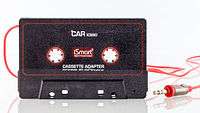Cassette tape adaptor

The cassette adapter allows one to play music through sound systems with a tape player without the need for an auxiliary input.
Usage
A cassette tape adapter is a device that allows the use of portable audio players in older cassette decks. This is useful for cars, which often lack inputs for portable devices. Originally designed to connect portable CD players to car stereos that only had cassette players, the cassette tape adapter has become popular with portable media players even on cars that have CD players built in. In the case of AM/FM systems without cassette playback, FM transmitters are recommended.
A typical cassette adapter uses a single-sided writing tape head (similar to the recording head on a traditional tape deck) connected to a stereo minijack connector with a cord. The cord is connected to the device's output (or headphones) port and the electrical signal is converted into a magnetic signal by the head. This magnetic signal is then received by the tape deck's reading head, converted back into an electrical signal, and amplified by the sound system. Because most cassette adapters use a single-sided head, they only work in one direction. There are, however, some cassette adapters that have double-sided heads that work in either direction.
A newer type of adapter is a type of cassette shaped mp3 player, which commonly can be used as a stand-alone mp3 player with headphones, or inserted as a cassette into the cassette player, where it can be used together with a remote control. These usually have a double sided head which means they can work in both directions.
A common alternative to cassette adapters is FM transmitters. These devices often require external power and convert the device's electrical signal into radio waves which are then transmitted over an unused FM frequency to a nearby FM tuner. The cassette adapter is usually considered superior as it is much less prone to interference.
Applications
- See also: FM transmitter (personal device)#Applications, this section has examples that apply here too.
A cassette adapter could also be used with other audio equipment, such as a microphone, handheld game console, or laptop computer. It can also be used in a home tape deck to play sound from any equipment, such as a personal computer, when computer speakers are in short supply.
- hands-free cellular (a microphone is also required for this application)
- CD player (the original application for cassette adapters)
- FM radio
- HD radio (for the large numbers of receivers that do not natively support this broadcast standard)
- laptop computer
- portable media players (iPod, MP3 player, Zune)
Mechanism
A cassette adapter is shaped like a cassette tape. However, instead of having reels of tape inside, it has a transmitting head where the tape is normally read by the reading head. This transmitting head is connected to the input cord, which connects the head to the audio source. A cassette adapter must also include a mechanism that simulates tape movement. Modern cassette players monitor tape movement to detect when the tape ends. This is done using a rolling wheel that rides against the tape. To simulate tape movement, a system of gears or a drive belt connects the tape player's drive motor (via the take-up spindle) to a wheel inside the adapter. This wheel rides against the detection wheel to simulate tape movement. Because the wheel never stops spinning, the deck never senses an end-of-tape and never tries to reverse the tape. Some adapters contain a one way locking mechanism, to stop the detection wheel if the tape is played in the wrong direction (and thus reading the wrong side of the head). The stopped wheel then would cause the cassette player to either stop the tape, or reverse the direction if the player supports it.
The practical and functional opposite of using a cassette adapter, is using a cassette player on an AUX input of a stereo that doesn't have a built-in cassette deck, which can be useful in some cases.
See also
| Wikimedia Commons has media related to Cassette adapter. |